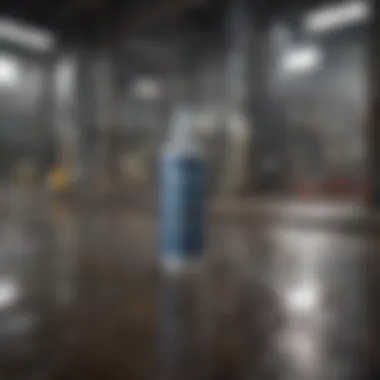Understanding Moisture Remover: Functions and Applications


Overview of Topic
Moisture removers play a crucial role in maintaining healthy indoor environments, especially in the home improvement industry. Moisture accumulation can lead to various problems including mold growth, structural damage, and poor air quality. Understanding how moisture removal works is essential for homeowners and housewives who want to ensure the comfort and safety of their living spaces.
The significance of managing moisture is underscored by its direct impact on health and property. Effective moisture control not only enhances the quality of indoor air but also protects homes from serious damage. With climate change and increasing humidity levels in many regions, knowing how moisture removers function is more important than ever.
Common Challenges and Solutions
Homeowners often face challenges related to excess moisture. Common issues include:
- Mold and mildew growth
- Wood rot in structural wood
- Musty odors in living spaces
- Damage to electronics and furnishings
To overcome these issues, it is important to implement effective moisture management strategies:
- Regular Inspection: Periodically check for leaks and damp spots in the home.
- Use Dehumidifiers: Invest in quality dehumidifiers to control humidity levels, especially in basements or during rainy seasons.
- Ventilation: Ensure proper ventilation in areas like bathrooms and kitchens where moisture tends to accumulate.
- Seal Cracks: Use sealants to close gaps in basements or near windows where moisture can seep in.
Product Recommendations
There are many moisture remover products on the market. These include:
- hOmeLabs Dehumidifier: Known for its energy efficiency and quiet operation, suitable for medium-sized rooms.
- Frigidaire FFAD5033W1: A robust unit designed for large spaces with a continuous drain option.
- Eva-Dry E-333: Ideal for small areas. It is compact and uses silica gel for moisture absorption.
Each of these products has specific benefits:
- Energy efficiency: Reduces electricity bills.
- Ease of use: Compact designs make them portable and user-friendly.
- Maintenance: Simple cleaning processes enhance durability.
Step-by-Step Guides
Implementing moisture removal solutions requires a systematic approach:
- Identify Moisture Sources: Look for leaks, condensation, or areas with poor ventilation.
- Choose the Right Moisture Remover: Based on your specific needs, select a dehumidifier or moisture absorber.
- Set Up the Device: Follow the manufacturer's instructions for optimal placement and settings.
- Regular Maintenance: Clean filters or replace components as advised to ensure continuous operation.
- Monitor Humidity Levels: Use a hygrometer to keep an eye on humidity levels, ideally around 30-50%.
"Effective moisture control leads to improved health and home longevity."
By taking these steps, homeowners can effectively manage moisture and enjoy a more comfortable living environment.
Prologue to Moisture Remover
Moisture removers are essential tools in managing humidity levels in various environments. This introduction serves to highlight their crucial role in preventing issues related to excess moisture. High humidity can lead to detrimental effects on both health and property. Therefore, understanding how moisture removers function and the different types available is significant for homeowners and housewives.
Definition of Moisture Remover
A moisture remover is a device or substance designed to absorb or eliminate excess moisture from the air. This can be achieved through various methods, including physical absorption and chemical processes. Mechanical dehumidifiers, for example, use electricity to cool air and condense water vapor. In contrast, chemical-based products might use salts or other absorbents to capture moisture naturally. By understanding what moisture removers are, one can better appreciate their necessity in both domestic and industrial contexts.
Importance in Different Environments
The importance of moisture removers cannot be overstated. In homes, they improve indoor air quality, which directly affects the occupants' health. Living in damp environments can lead to respiratory problems and mold growth, making moisture control a top priority. In industrial settings, excessive moisture can compromise product quality and safety. Thus, implementing an effective moisture management strategy is not just beneficial but is often critical.
"Moisture management plays a key role in enhancing comfort and protecting property from damage."
In commercial spaces, such as retail, a controlled humidity level impacts both customer experience and product preservation, making moisture removers vitally important across various sectors. By managing moisture effectively, one can foster a safer and more appealing environment.
The Science of Moisture Accumulation
The science behind moisture accumulation plays a critical role in understanding how moisture affects our environments. It is key for homeowners and individuals wishing to maintain a healthy indoor climate. Excess moisture can lead to significant issues such as mold growth, structural damage, and health problems. Thus, grasping the fundamental aspects of humidity and its sources is indispensable in moisture management.
Understanding Humidity
Humidity refers to the amount of water vapor present in the air. It can be a crucial factor in comfort levels and air quality. Relative humidity is a common measure, indicating how much moisture the air holds compared to its maximum capacity at a certain temperature. When humidity levels rise above 60 percent, the environment becomes ripe for issues like mold and mildew.
There are two main types of humidity: absolute humidity and relative humidity. Absolute humidity measures the actual amount of water vapor in the air, while relative humidity is a percentage that describes current conditions relative to temperature. Maintaining moderate humidity, typically between 30% and 50%, ensures a comfortable atmosphere, free from excess moisture.
Causes of Excess Moisture
Excess moisture can stem from a variety of sources, both natural and man-made. It is crucial to identify these causes to combat moisture effectively. Some common contributors include:


- Weather Conditions: Areas with high rainfall or high humidity can indirectly contribute to excess moisture indoors.
- Poor Ventilation: Inadequate airflow in homes or buildings can trap humidity. This is particularly common in basements and attics, where moisture can accumulate unnoticed.
- Cooking and Bathing: Everyday activities like cooking and showering release steam into the air. Without proper ventilation, this steam contributes to higher humidity levels.
- Water Leaks: Leaky pipes or roof leaks can introduce water into the various structures of a home, creating damp conditions that encourage mold growth.
- Damp Basements: Basements are particularly prone to moisture issues, often due to poor drainage or grading, which allows water to seep into the foundation.
By understanding these conditions, homeowners can better manage moisture levels in their environments, thereby minimizing potential risks linked to high humidity.
Types of Moisture Removers
Moisture removers play a crucial role in maintaining a dry and healthy environment. Understanding the various types of moisture removers is essential for selecting the right option based on individual circumstances. Each category offers specific solutions to combat excess humidity. This section delves into the types of moisture removers, highlighting their unique characteristics, advantages, and considerations.
Mechanical Moisture Removers
Mechanical moisture removers, commonly referred to as dehumidifiers, are devices designed to reduce humidity levels in a confined space. They function by drawing in moist air, passing it over cold coils, and condensing the moisture into water, which is then collected in a tank or drained directly. These devices are highly effective in areas prone to high humidity, such as basements and laundry rooms.
Mechanical moisture removers help to prevent mold growth and eliminate musty odors in enclosed spaces.
The benefits of mechanical removers include:
- Adjustable settings: Many models come with adjustable humidity settings, allowing users to control moisture levels according to their needs.
- Real-time monitoring: Several units are equipped with built-in hygrometers, providing real-time humidity levels.
- Versatility: They can be used in homes, garages, and even commercial spaces as needed.
However, users should consider the energy consumption of these devices. They may require significant power to operate, leading to increased electricity costs. It is advisable to look for energy-efficient models to mitigate this impact.
Chemical Absorbents
Chemical absorbents, such as silica gel and calcium chloride, are materials designed to attract and trap moisture from the air. These substances each possess unique properties that make them suitable for various applications. For example, silica gel is often used in small packets and is commonly found in product packaging to protect electronics and food items from humidity.
The key advantages of chemical absorbents include:
- Affordability: They are usually more cost-effective than mechanical options, making them accessible for households with budget constraints.
- Low maintenance: Many chemical absorbents can be reused by drying them out, which extends their lifespan.
- Compactness: Their small size allows for easy placement in areas like closets, drawers, or storage bins.
Nonetheless, chemical absorbents may not effectively reduce humidity in larger spaces. It is essential to assess the area size before selecting this method as the primary means of moisture removal.
Natural Absorbents
Natural absorbents, including substances like baking soda, activated charcoal, and salt, provide eco-friendly solutions for moisture control. These materials are biodegradable and can be safely disposed of or recycled. They work by adsorbing moisture from the air, thereby helping to reduce humidity levels naturally.
Some notable points about natural absorbents are:
- Environmental impact: They are often more sustainable than chemical alternatives.
- Cost-effective: Many natural absorbents can be easily found in homes, lowering the necessity for specialized purchases.
- Health safety: They tend to be non-toxic and pose minimal health risks to users and pets.
Despite these benefits, natural absorbents may require frequent replacement or replenishment to maintain their efficacy. They are best suited for smaller areas where excess moisture is a persistent concern, like bathrooms or kitchen cabinets.
By understanding the distinct types of moisture removers—mechanical, chemical, and natural—individuals can make informed decisions tailored to their specific needs. Each type offers its own set of benefits and limitations, and careful consideration ensures optimal results in moisture management.
How Moisture Removers Work
Understanding how moisture removers operate is crucial for homeowners and housewives alike. Selecting the right device or method can greatly improve living conditions. This knowledge also protects valuable items from damage. Moreover, moisture control in the air contributes positively to overall health.
Mechanisms of Action
Moisture removers utilize different principles to absorb or eliminate excess humidity in the environment. The most common mechanisms include:
- Desiccation: This process involves materials that attract and hold moisture. Silica gel and activated charcoal are examples. They physically trap humidity, making them effective in small spaces like closets or containers.
- Condensation: Devices like dehumidifiers remove moisture from the air by cooling it. When air cools, its ability to hold water vapor decreases. Hence, water condenses on coils inside the unit, collecting in a tank.
- Evaporation: Some products, like gel-based moisture absorbers, release moisture back into the air after reaching saturation. This happens until they can no longer absorb more humid air. This mechanism is less common but still effective in low humidity conditions.
The choice of mechanism impacts effectiveness in various environments. For example, condensation-based methods excel in areas with high humidity, while desiccants work well in smaller, enclosed spaces. Understanding these mechanisms enables better decision-making in moisture control.
Energy Consumption and Efficiency
Energy usage is a critical factor when considering moisture removers. Devices vary in their power requirements and operational efficiency.
- Energy Ratings: Look for options with better energy ratings. Energy-efficient models often use less electricity and can save money in the long run.
- Size Matters: Larger units may seem more effective but can consume more energy. Matching the size of the device to the area it serves is essential.
- Continuous Operation: Some moisture removers are meant for continuous operation, while others work intermittently. Continuous systems might draw more power but can also be programmed to run during off-peak hours.
To summarize, the efficiency of moisture removers is closely linked to their energy usage. Homeowners should aim to balance operation costs with effective moisture control.
Moisture control is not just about comfort; it significantly influences health and property longevity.
Applications of Moisture Remover


Understanding the applications of moisture removers is vital in grasping their overall significance. They play critical roles in homes, workplaces, and industries, affecting both air quality and material preservation. As humidity levels fluctuate, moisture accumulators can lead to various issues. In residential spaces, moisture build-up in places like basements can promote mold growth and compromise the integrity of structures. In industrial settings, excessive moisture can disrupt manufacturing processes and reduce the quality of products. Consequently, a tailored approach to moisture management can vastly improve health, safety, and efficiency across different environments.
In Residential Settings
Usage in Basements
Basements are often prone to high moisture levels due to their location below ground. Using moisture removers effectively in these spaces is essential. This practice contributes to a healthier environment and can help prevent significant damage due to dampness. **A popular choice for controlling moisture in basements is the use of dehumidifiers. They work by drawing in humid air, extracting moisture, and releasing drier air back into the room. The result is a lower humidity level that mitigates risks like mold and mildew.
One key characteristic of basement moisture management is the ability to monitor humidity levels. Many modern dehumidifiers come with built-in hygrometers, allowing homeowners to adjust settings based on specific humidity thresholds. This capability ensures optimal performance and energy efficiency.
Although effective, users should be aware of the energy consumption associated with dehumidifiers. While they can significantly lower humidity levels, continuous operation may increase energy costs.
Effect on Air Quality
The impact of moisture removers on air quality is a significant benefit. High humidity can lead to the proliferation of mold spores and dust mites, thus affecting indoor air quality. Using dehumidifiers in residential settings helps to reduce moisture levels, leading to cleaner, healthier air.
An important characteristic of this process is the reduction in allergens typically found in high-humidity environments. Improved air quality can yield positive outcomes for individuals with respiratory issues or allergies. Prevention of mold also contributes to better indoor air, which is vital for health. However, one must ensure the unit is maintained properly to prevent dust and mold accumulation within the device itself.
In Industrial Applications
Role in Manufacturing Processes
In industrial settings, moisture control is essential for maintaining product quality and operational efficiency. Excess moisture can adversely affect materials, leading to downtime or increased waste. Implementing moisture removers helps to manage humidity effectively, contributing to optimized manufacturing processes.
One notable feature includes automation in moisture control systems. Many factories now employ advanced monitoring systems that instantly adjust dehumidification levels based on real-time data. This adaptability allows industries to maintain constant conditions necessary for processing sensitive materials.
However, reliance on automated systems must be balanced with regular maintenance. Checking and calibrating equipment is crucial to avoid potential failures that might disrupt production.
Impact on Product Quality
The quality of products in manufacturing can be directly influenced by moisture levels during production. High humidity can lead to defects in products, such as warping in wood or paint issues in coatings. Utilizing moisture removers helps ensure that the atmosphere remains within optimal parameters, thus protecting product integrity.
One key aspect of this is the preservation of raw materials. For instance, industries dealing with wood or textiles often require specific humidity levels. Moisture control can lead to better-quality goods that meet industry standards. However, improper moisture management can lead to increased costs if materials become damaged.
In Commercial Spaces
Moisture Management in Retail Environments
In retail environments, maintaining optimal moisture levels is crucial. Displays and products must be free from dampness that could lead to spoilage or damage. Retail spaces often utilize moisture removers strategically to manage humidity, thus protecting inventory and enhancing shopping experiences.
A distinct feature of moisture control in retail is the need for both visibility and comfort. Customers prefer comfortable shopping climates, which can be hindered by humidity. An effective moisture management system can help keep air quality stable, benefiting both merchandise and customer satisfaction.
One challenge in these environments is balancing cost with effectiveness. Choosing the right equipment that meets the store's needs while remaining within budget can be demanding.
Preservation of Sensitive Equipment
Finally, preserving sensitive equipment is critical in commercial spaces such as server rooms or laboratories. Equipment in these areas can be highly susceptible to moisture damage. Utilizing moisture removers protects these assets, ensuring they function correctly and last longer.
An important characteristic of these moisture management systems is their ability to operate silently, which is vital in settings where noise can cause disruptions. Additionally, these systems can include alarms that trigger in case of moisture levels exceeding set thresholds.
However, it is crucial to select moisture removers that meet the specific requirements of the equipment involved. Overly aggressive moisture extraction can lead to dryness that may affect equipment performance.
In summary, understanding the multifaceted applications of moisture removers is key to improving both health and efficiency across a wide range of environments.
Health Considerations
When discussing moisture removers, health considerations hold significant weight. One may argue that moisture management directly influences the overall well-being of individuals in various environments. High humidity presents a number of health risks that might not be readily apparent yet can have a long-term effect on one's quality of life. Understanding these risks associated with excessive moisture is essential for homeowners and housewives who seek to maintain a healthy living space.
Impact of High Humidity on Health
High humidity creates an ideal environment for mold, mildew, and dust mites to thrive. Prolonged exposure to damp conditions can lead to respiratory issues, allergies, and other health problems. Individuals with asthma or other pulmonary conditions may find that high humidity exacerbates their symptoms. Elevated moisture levels can also contribute to the growth of harmful bacteria, which can pose further health risks.
Some of the common symptoms experienced due to high humidity include:
- Coughing
- Sneezing
- Sinus congestion
- Itchy eyes
- Skin irritations


It is vital to recognize these signs and address high humidity promptly. Effective moisture removal can significantly improve indoor air quality and safeguard health.
Safety for Users of Moisture Removers
While moisture removers play a crucial role in enhancing air quality, safety remains a primary concern for users. Different types of moisture removers come with various operational mechanisms and safety protocols. Key safety considerations include understanding how to use devices correctly and being aware of any potential hazards associated with certain products.
Here are some important safety tips to consider:
- Read labels and manuals: Always adhere to the manufacturer's guidelines for usage.
- Ventilation: Ensure proper ventilation when using chemical-based moisture removers.
- Keep out of reach: Store moisture remover products away from children and pets.
- Monitor energy use: For electrical appliances, verify energy consumption to avoid overheating.
By being informed and vigilant, users can maximize the effectiveness of moisture removers while minimizing health risks associated with improper use or high humidity.
Recognizing the health implications of moisture accumulation is foundational in choosing appropriate solutions. The right moisture removal strategy will not only enhance comfort but also protect health in residential settings.
Choosing the Right Moisture Remover
Selecting the appropriate moisture remover is a critical aspect when dealing with dampness in homes or commercial spaces. The right choice can lead to improved air quality, protection against mold growth, and preservation of property. This section focuses on the vital elements to keep in mind while choosing a moisture remover and the benefits that come from making an informed decision.
Factors to Consider
When choosing a moisture remover, several factors must be taken into account:
- Room Size: Measure the space where the moisture remover will be used. Larger areas may require more powerful devices, while smaller spaces can benefit from portable units.
- Type of Moisture Problem: Identify whether the issue is persistent humidity or sudden dampness. For consistent moisture, dehumidifiers might be appropriate, while moisture absorbers suit temporary issues.
- Energy Efficiency: Look for energy-efficient models that reduce electricity costs without sacrificing performance. Check the Energy Star ratings and consider reviews for insights.
- Maintenance Requirements: Some devices need regular upkeep, such as filter replacement or water disposal. Ensure that you are comfortable with the maintenance demands of your chosen product.
- Noise Level: In quieter environments like bedrooms, consider the noise output of the moisture remover. Look for models designed to operate silently.
Comparative Cost Analysis
Cost can be a determining factor in choosing a moisture remover. It's essential to assess both the initial purchase price and long-term expenses, which include:
- Initial Investment: Various products have different price points. Compare models based on features. Some high-end units may offer advanced technology, while budget options may suffice for typical household needs.
- Operating Costs: Review the energy consumption ratings. An efficient model may have a higher upfront cost but can save money in the long run through reduced energy bills.
- Replacement Costs: If the product uses replaceable components, factor in the cost of these parts when evaluating overall affordability.
- Potential Savings: Consider the potential financial implications of dealing with moisture problems, such as mold remediation or property damage. Investing in a quality moisture remover can prevent higher costs in the future.
Choosing the right moisture remover is not just about the initial cost but also about considering long-term benefits and potential savings.
By thoughtfully considering these factors and conducting a comparative analysis of costs, individuals can make an informed decision that not only resolves their moisture issues but also enhances their living environment.
Future Developments in Moisture Management
The landscape of moisture management is consistently evolving. This section will explore the future innovations and considerations in this field. Advances in technology present opportunities for improved efficiency and effectiveness in moisture removal, highlighting why continual attention to development is vital.
Innovations in Technology
The future of moisture management relies heavily on technological progress. Smart moisture removers are emerging. They feature sensors that monitor humidity levels in real-time. These devices can automatically adjust their operation based on current conditions. This results in better energy efficiency and improved moisture control.
Another significant innovation is the integration of artificial intelligence. AI algorithms can learn user habits and adapt their functioning accordingly. For example, if a certain room is usually humid after cooking, the device can be programmed to activate at those times. These advancements not only improve user convenience but also enhance the effectiveness of moisture removal.
Moreover, the development of advanced materials for moisture absorbers is on the rise. Nanotechnology is enabling the creation of absorbents that can work more efficiently with less energy. The emergence of biodegradable absorbents can also be observed. This is essential for meeting consumer demand for products that have minimal environmental impact.
Environmental Impact and Sustainability
As the focus on sustainability increases, the future of moisture management must consider environmental impacts. Current moisture removal technology can sometimes lead to high energy consumption. This is where new best practices can come into play. Future developments should aim for sustainable materials and energy-efficient designs.
The emphasis on reducing carbon footprint cannot be overlooked. Manufacturers are under pressure to produce moisture removers that minimize ecological damage. Using recyclable and sustainable materials in manufacturing processes is a big step toward this goal.
Furthermore, manufacturers are encouraged to provide energy ratings for their products. Such transparency allows consumers to make informed decisions. Reducing energy consumption, while maximizing effectiveness, aligns with broader sustainability goals.
Looking ahead, the balance between effective moisture control and environmental responsibility will be a significant focus for future innovations.
Epilogue
In this article, we have explored the complex but essential role of moisture removers in various settings. The conclusion brings together several key elements that underline the significance of moisture management in everyday life and industry. Moisture removers are not just tools; they are critical components for maintaining a healthy indoor environment and protecting property from damage.
Recap of Key Points
- Understanding Moisture Accumulation: Recognizing the science behind humidity and its causes helps in selecting the right moisture remover. Excess moisture can damage structures and compromise health.
- Types of Moisture Removers: Different types such as mechanical, chemical, and natural absorbents serve unique functions. Each type has its advantages and limitations.
- Applications Across Settings: Knowledge of where moisture removers are applied, such as in residential, industrial, and commercial spaces highlights their versatility and importance. Their role in improving air quality and safeguarding equipment is notable.
- Health Considerations: High humidity affects well-being. Understanding how moisture removers can mitigate these issues ensures safety for users.
- Choosing the Right Solution: Factors like cost, efficiency, and environmental impact must be weighed carefully. The right choice leads to better outcomes in moisture management.
- Future Innovations: The ongoing developments in moisture management technology promise improvements in effectiveness and sustainability.
Final Thoughts on Moisture Management
Effective moisture management is crucial. It impacts comfort, health, and longevity of structures. For housewives and homeowners, being informed about moisture removers can result in a more pleasant living environment.
Considering trends towards eco-friendly solutions, opting for natural absorbents or energy-efficient mechanical systems could also be beneficial. As we advance, staying aware of new developments will further equip homeowners to tackle moisture-related issues effectively.
In essence, mastering moisture management is key. Recognizing its importance leads not only to a healthier environment but also protects personal investments.







